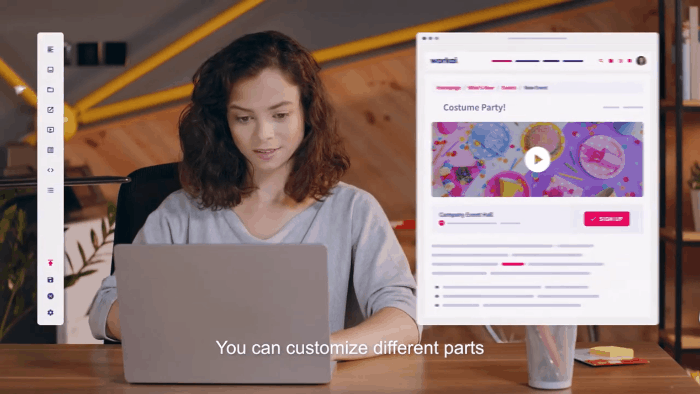

5 examples of employee engagement strategies for remote work
The world has changed, so the internal comms. Even before the pandemic, which forced people to work remotely, it was challenging for IC managers to keep people informed, engaged, and connected at the same time.
Now, with the rapid change of approach, multiple new tools, and no in-person interactions, it’s more important than ever to find and execute new employee engagement strategies to make the internal communication clear, straightforward, and engaging– for people working remotely at their homes, and those preferring a hybrid way of working.
NEW WAYS OF WORKING – NEW EMPLOYEE ENGAGEMENT STRATEGIES
Working in distracting conditions and an atmosphere of danger is not conducive to good communication. In such extreme conditions, employers are forced to look for solutions supporting the communication and information flow. The aim is to help the employees not only to cooperate well but also to take care of their well-being. Although a long time has passed since the pandemic outbreak, and the situation seems to be calmer now, a lot has changed in the approach to the workplace.
Remote jobs are advertised every day, and more organizations allow their employees to stay remote. You also hear about hybrid work a lot more often. Today, employees can decide for themselves where they want to work. According to recent Qualtrics research, 80% of employees consider remote work an important option when choosing a new job!
FUTURE IS REMOTE
The number of businesses that have adopted remote work since the beginning of the crisis is difficult to quantify, but Gartner experts share some hints in one of their latest surveys. They surveyed 800 global HR executives and found that 88 % of companies allowed or needed workers to work from home, regardless of whether they showed symptoms associated with coronavirus or not.
However, along with its many benefits, remote work tends to make workers feel separated, directly affecting the team’s success, cooperation, and employee retention.
HOW REMOTE WORK AFFECTS INTERNAL COMMUNICATION?
Working in a team where each person is in a different place requires an adapted approach and proper, constant attention to ensure communication quality. In this case scenario, it is easier to let unverified information circulate, distort findings or speculate. Therefore, the manager’s task is to establish communication rules for each grade (and between them). This way, each employee can count on a consistent message from their superiors and stay in touch with other team members. That, of course, requires a whole new strategy and the use of communication support tools.
It is easier to get distracted or lose motivation for work when you are at home and your work is not supervised. Interest levels can drop quickly, especially when you feel isolated and disconnected from others.
Improving the strategy of internal communication with remote employees in mind has several important goals to meet:
- to ensure effective onboarding and training,
- to provide the employees with verified information,
- to support the working processes in a dispersed team,
- to build a sense of community among employees,
- to get feedback, analyze, improve, and repeat.
REMOTE EMPLOYEE ENGAGEMENT STRATEGY
For a long time, the satisfaction and engagement of the employees have been tested using the annual surveys. Along with the growing concern for employee experience, it became necessary to search for new solutions and strategies. It is no different in the case of remote workers. By analyzing their engagement, managers can react faster, adapting the tools to the employee’s needs.
Why is employee engagement crucially important?
By providing employees with the right tools and caring for their well-being at work, you build their motivation to engage them in tasks and activities. This approach contributes to the success of the entire organization. You can make your employees more engaged by publishing creative content on your intranet! How you communicate with your employees has a severe impact on their well-being.
HOW TO KEEP REMOTE EMPLOYEES ENGAGED?
Here are some tips on how a well-executed internal communication strategy can engage the workforce collaborating remotely:
1. Diversify voices and invite employees to co-create your internal comms
B2C marketing strategy thrives on the power of brand ambassadors. Marketers capitalize on popular and recognizable names from actors, YouTube stars, and Instagram influencers to help get their messages across. A company’s words, spoken out of ambassadors’ mouths, seem more real and more trustworthy. Why not make employees your brand ambassadors and let them co-create internal content? In the end, we pay more attention to what was delivered by a familiar person or one that shares the same experience or plays a similar role.
PRO TIP: Always try to find the most suitable person to deliver critical information. For example, an important safety announcement is best provided by a worker directly or indirectly affected by an incident or a near miss. Let proven internal influencers tell their stories and use them to promote your culture and company values.
Another way to engage your employees personally is to tag particular people in your message. For example, in the intranet article, you can convey a new concept, a new program, an update from a remote colleague. Social tagging alerts them to the mention and allows individuals who may not have met in person for a while to reconnect. Also, it implies that the employee is respected, significant, and essential to many activities within the business.
2. Let your employees play games
The popularity of online gaming continues to explode around the world. No wonder that employers are eager to use competitive solutions. In this way, they have a positive effect on employee experience and increase interaction between employees. Gamification in the enterprise takes advantage of the natural human need to compete.
For example, if your team is not very active on the company intranet, they need some incentives. They will feel way more motivated to be interacting on internal social media posts and thus fulfill the goals you are trying to accomplish by designing a way that encourages the employee to play a game that provides points, status, and incentives. A jogging scoreboard in all the regional offices may be an example of this.
Teams may be formed to play in a national or international contest within divisions with the results reported on the company intranet. It allows individuals to join, observe the results, and exchange congratulations. It is a great way to encourage employee interaction and an effective means for getting people to adopt internal communication channels.
3. Spice up your message with podcasts, videos, hashtags, emojis, and gifs
🔊 Podcasts – we highly recommend creating podcasts to distribute critical internal organizational messages, inform and integrate teams. Providing information in the form of a podcast makes the content engaging and easier to assimilate. It is also a great idea to reach non-desk staff, sales, and support teams with relevant content. This way, workers who are constantly on the go can benefit from features such as offline listening and “car mode” and get familiarized with the content while traveling.
🎬 Videos – watching a short movie to learn about new processes or corporate updates is quick and enjoyable. It is much easier to convey emotions and tell a story more energetically in a video than via a written form. Video also allows your employees to relate to the message given instantly. All you need is some basic equipment to shoot a video, edit it, and then publish it on your internal communication channels.
🔖#Hashtags – not just the sole preserve of social media, hashtags carry out an important role by acting as a marker for a particular topic. The benefits are considerable, and hashtags can have a useful role to play in aiding collaboration by grouping specific conversations so that those who choose to be involved can contribute and be heard. They help create a hub of accessible information by making it easy and efficient to search for and find the latest information about important topics such as updates on pandemic-related restrictions etc.
😀 Emojis – you can use emojis if you want to make the message less formal and personable. When you use them, your message automatically becomes friendlier and more humorous. Using emojis makes the communication more personal and brings the conversation to a less formal level. However, you must be careful and not use them in inappropriate situations. There is also no place for them in legal texts or documents.
📺 GIFs – just as people use GIFs to communicate their reactions to something, so can companies. GIFs are popular because they easily catch your attention. They are engaging and memorable. As they are mobile-friendly, they can work on diverse platforms. The most important is that GIFs make the content memorable and easier to absorb. Videos are often too expensive, whereas GIFs are short, cheap, and fun. Animated GIFs simplify communication.
4. Recognize your employees’ efforts – the basis of the strategy
When working remotely, people tend to feel disconnected. Communication can drop, spontaneous interaction by the coffee machine is now non-existent, and we have a to-do list to be executed. Gradually, this can harm the quality of work, productivity, and attitudes.
Human beings need acknowledgment and attention, and this can be provided efficiently through the company intranet. The recognition process can suit the company’s needs and values. The most popular ones are where the entire organization can recognize a colleague for excellent work, good support, or an act of kindness. When you focus on appreciation and joy, it is contagious and spreads when everyday fine deeds are shared with the staff. They carry an enormous influence on your work culture. Showing gratitude to others can have a profound effect on your workplace’s emotional contagion.
According to Gallup’s study, employees who receive recognition regularly increase their productivity, receive higher loyalty and satisfaction scores from customers, and are more likely to stay with their organization.
5. Why employee engagement strategies are more important than ever
The dry, formal, and top-down information flow is no longer enough to connect with your remote workers. Your employees need much more, and when they are isolated, they expect it more than ever.
Personalized, always relevant, and visually attractive: your comms need to grab the attention of your remote employees. While some workers are just focused on getting their job done and returning to their private lives, your comms can do more than simply provide dry information.
Efficient comms can be inspiring and supportive so that employees can contribute to the culture, establish efficient working relationships, and feel more empowered to fulfill their objectives. Of course, you cannot implement an efficient communication strategy in your organization without the proper tools.
HOW DOES WORKAI HELP INTERNAL COMMS MANAGERS EXECUTE EMPLOYEE ENGAGEMENT STRATEGIES?
Some multiple strategies and tools can support managers in the process of keeping people informed, engaged, and connected – intranets, SharePoint sites, Teams, Zoom, Slack, Yammer, and many, many more. The key is to leverage the tools that can give you the holistic overview of internal communication across all channels, departments, and locations – to measure the information’s impact and act faster in an ever-changing distributed work environment.
At Workai, we believe people should not be limited by complicated technology, but rather the tools should support them in executing their internal comms strategies with more confidence and with better results. That is why Workai’s comms-friendly drag-and-drop CMS allows people without any need for IT or graphic design skills to publish engaging, personalized, and high-performing content using ready-made content blocks and content types. We integrated our platform with MS Teams and Microsoft 365 to make information flow even smoother.
With Workai, IC managers can finally run personalized internal campaigns and add content and medium (news, banners, pop-ups, newsletters, sliders, videos, podcasts, files, documents, and more), setting the exact audience and setting the exact audience measure the impact with real-time analytics.
Workai also supports remote and distributed teams with effective engagement boosters – social communities, surveys, kudos, crowdsourcing campaigns, lotteries, events, live virtual town halls, and more – adding integrations with the tools you already use.
We work closely with hundreds of enterprises to ensure that each Workai feature supports people responsible for internal communication and employee engagement in their daily challenges – for remote, hybrid, and onsite workers.

